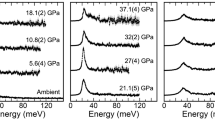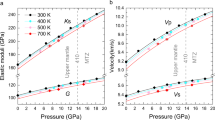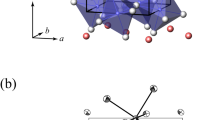Abstract
The chemical composition of Earth’s lower mantle can be constrained by combining seismological observations with mineral physics elasticity measurements1,2,3. However, the lack of laboratory data for Earth’s most abundant mineral, (Mg,Fe,Al)(Al,Fe,Si)O3 bridgmanite (also known as silicate perovskite), has hampered any conclusive result. Here we report single-crystal elasticity data on (Al,Fe)-bearing bridgmanite (Mg0.9Fe0.1Si0.9Al0.1)O3 measured using high-pressure Brillouin spectroscopy and X-ray diffraction. Our measurements show that the elastic behaviour of (Al,Fe)-bearing bridgmanite is markedly different from the behaviour of the MgSiO3 endmember2,4. We use our data to model seismic wave velocities in the top portion of the lower mantle, assuming a pyrolitic5 mantle composition and accounting for depth-dependent changes in iron partitioning between bridgmanite and ferropericlase6,7. We find excellent agreement between our mineral physics predictions and the seismic Preliminary Reference Earth Model8 down to at least 1,200 kilometres depth, indicating chemical homogeneity of the upper and shallow lower mantle. A high Fe3+/Fe2+ ratio of about two in shallow-lower-mantle bridgmanite is required to match seismic data, implying the presence of metallic iron in an isochemical mantle. Our calculated velocities are in increasingly poor agreement with those of the lower mantle at depths greater than 1,200 kilometres, indicating either a change in bridgmanite cation ordering or a decrease in the ferric iron content of the lower mantle.
This is a preview of subscription content, access via your institution
Access options
Access Nature and 54 other Nature Portfolio journals
Get Nature+, our best-value online-access subscription
$29.99 / 30 days
cancel any time
Subscribe to this journal
Receive 51 print issues and online access
$199.00 per year
only $3.90 per issue
Buy this article
- Purchase on Springer Link
- Instant access to full article PDF
Prices may be subject to local taxes which are calculated during checkout




Similar content being viewed by others
Change history
16 May 2018
In this Letter, some of the elastic constants reported in Extended Data Table 1 and the values of the elastic constants at room pressure cited in the manuscript on page 544 were incorrect, as a result of an error in the script used to generate the numbers. These errors have been corrected online.
References
Cammarano, F., Marquardt, H., Speziale, S. & Tackley, P. J. Role of iron-spin transition in ferropericlase on seismic interpretation: a broad thermochemical transition in the mid mantle? Geophys. Res. Lett. 37, L03308 (2010)
Murakami, M., Ohishi, Y., Hirao, N. & Hirose, K. A perovskitic lower mantle inferred from high-pressure, high-temperature sound velocity data. Nature 485, 90–94 (2012)
Cobden, L. et al. Thermochemical interpretation of 1-D seismic data for the lower mantle: the significance of nonadiabatic thermal gradients and compositional heterogeneity. J. Geophys. Res. 114, B11309 (2009)
Chantel, J., Frost, D. J., McCammon, C. A., Jing, Z. & Wang, Y. Acoustic velocities of pure and iron-bearing magnesium silicate perovskite measured to 25 GPa and 1200 K. Geophys. Res. Lett. 39, L19307 (2012)
Ringwood, A. E. A model for the upper mantle. J. Geophys. Res. 67, 857–867 (1962)
Nakajima, Y., Frost, D. J. & Rubie, D. C. Ferrous iron partitioning between magnesium silicate perovskite and ferropericlase and the composition of perovskite in the Earth’s lower mantle. J. Geophys. Res. 117, B08201 (2012)
Irifune, T. et al. Iron partitioning and density changes of pyrolite in Earth’s lower mantle. Science 327, 193–195 (2010)
Dziewonski, A. M. & Anderson, D. L. Preliminary reference Earth model. Phys. Earth Planet. Inter. 25, 297–356 (1981)
McCammon, C. Perovskite as a possible sink for ferric iron in the lower mantle. Nature 387, 694–696 (1997)
Wang, X., Tsuchiya, T. & Hase, A. Computational support for a pyrolitic lower mantle containing ferric iron. Nat. Geosci. 8, 556–559 (2015)
Zhang, S., Cottaar, S., Liu, T., Stackhouse, S. & Militzer, B. High-pressure, temperature elasticity of Fe- and Al-bearing MgSiO3: implications for the Earth’s lower mantle. Earth Planet. Sci. Lett. 434, 264–273 (2016)
Marquardt, H. & Marquardt, K. Focused Ion Beam preparation and characterization of single-crystal samples for high-pressure experiments in the diamond-anvil cell. Am. Mineral. 97, 299–304 (2012)
Sinogeikin, S. V., Zhang, J. & Bass, J. D. Elasticity of single crystal and polycrystalline MgSiO3 perovskite by Brillouin spectroscopy. Geophys. Res. Lett. 31, L06620 (2004)
Li, L. et al. Elasticity of (Mg, Fe)(Si, Al)O3-perovskite at high pressure. Earth Planet. Sci. Lett. 240, 529–536 (2005)
Yeganeh-Haeri, A. Synthesis and re-investigation of the elastic properties of single-crystal magnesium silicate perovskite. Phys. Earth Planet. Inter. 87, 111–121 (1994)
Li, B. & Zhang, J. Pressure and temperature dependence of elastic wave velocity of MgSiO3 perovskite and the composition of the lower mantle. Phys. Earth Planet. Inter. 151, 143–154 (2005)
Boffa Ballaran, T. et al. Effect of chemistry on the compressibility of silicate perovskite in the lower mantle. Earth Planet. Sci. Lett. 333–334, 181–190 (2012)
Shukla, G., Cococcioni, M. & Wentzcovitch, R. M. Thermoelasticity of Fe3+- and Al-bearing bridgmanite: effects of iron spin crossover. Geophys. Res. Lett. 43, 5661–5670 (2016)
Jackson, J. M., Zhang, J., Shu, J., Sinogeikin, S. V. & Bass, J. D. High-pressure sound velocities and elasticity of aluminous MgSiO3 perovskite to 45 GPa: implications for lateral heterogeneity in Earth’s lower mantle. Geophys. Res. Lett. 32, L21305 (2005)
Murakami, M., Sinogeikin, S. V., Hellwig, H., Bass, J. D. & Li, J. Sound velocity of MgSiO3 perovskite to Mbar pressure. Earth Planet. Sci. Lett. 256, 47–54 (2007)
Lin, J.-F., Speziale, S., Mao, Z. & Marquardt, H. Effects of the electronic spin transitions of iron in lower-mantle minerals: implications to deep-mantle geophysics and geochemistry. Rev. Geophys. 51, 244–275 (2013)
Frost, D. J. et al. Experimental evidence for the existence of iron-rich metal in the Earth’s lower mantle. Nature 428, 409–412 (2004)
Sinmyo, R., Hirose, K., Muto, S., Ohishi, Y. & Yasuhara, A. The valence state and partitioning of iron in the Earth’s lowermost mantle. J. Geophys. Res. 116, B07205 (2011)
Fukao, Y. & Obayashi, M. Subducted slabs stagnant above, penetrating through, and trapped below the 660 km discontinuity. J. Geophys. Res. 118, 2013JB010466 (2013)
Tackley, P. J. Mantle convection and plate tectonics: toward an integrated physical and chemical theory. Science 288, 2002–2007 (2000)
Walter, M. J. et al. Deep mantle cycling of oceanic crust: evidence from diamonds and their mineral inclusions. Science 334, 54–57 (2011)
Jackson, I. Elasticity, composition and temperature of the Earth’s lower mantle: a reappraisal. Geophys. J. Int. 134, 291–311 (1998)
Smith, E. M. et al. Large gem diamonds from metallic liquid in Earth’s deep mantle. Science 354, 1403–1405 (2016)
Marquardt, H., Speziale, S., Reichmann, H. J., Frost, D. J. & Schilling, F. R. Single-crystal elasticity of (Mg0.9Fe0.1)O to 81 GPa. Earth Planet. Sci. Lett. 287, 345–352 (2009)
Zhang, Z., Stixrude, L. & Brodholt, J. Elastic properties of MgSiO3-perovskite under lower mantle conditions and the composition of the deep Earth. Earth Planet. Sci. Lett. 379, 1–12 (2013)
Catalli, K. et al. Effects of the Fe3+ spin transition on the properties of aluminous perovskite—new insights for lower-mantle seismic heterogeneities. Earth Planet. Sci. Lett. 310, 293–302 (2011)
Xu, Y. & McCammon, C. Evidence for ionic conductivity in lower mantle (Mg,Fe)(Si,Al)O3 perovskite. J. Geophys. Res. 107, 2251 (2002)
Rudolph, M. L., Lekic´, V. & Lithgow-Bertelloni, C. Viscosity jump in Earth’s mid-mantle. Science 350, 1349–1352 (2015)
Marquardt, H., Speziale, S., Koch-Müller, M., Marquardt, K. & Capitani, G. C. Structural insights and elasticity of single-crystal antigorite from high-pressure Raman and Brillouin spectroscopy measured in the (010) plane. Am. Mineral. 100, 1932–1939 (2015)
Schulze, K., Buchen, J., Marquardt, K. & Marquardt, H. Multi-sample loading technique for comparative physical property measurements in the diamond-anvil cell. High Press. Res. (in the press)
Kantor, I. et al. BX90: A new diamond anvil cell design for X-ray diffraction and optical measurements. Rev. Sci. Instrum. 83, 125102 (2012)
Kurnosov, A. et al. A novel gas-loading system for mechanically closing of various types of diamond anvil cells. Rev. Sci. Instrum. 79, 045110 (2008)
Whitfield, C. H., Brody, E. M. & Bassett, W. A. Elastic moduli of NaCl by Brillouin scattering at high pressure in a diamond anvil cell. Rev. Sci. Instrum. 47, 942–947 (1976)
Sinogeikin, S. V. & Bass, J. D. Single-crystal elasticity of pyrope and MgO to 20 GPa by Brillouin scattering in the diamond cell. Phys. Earth Planet. Inter. 120, 43–62 (2000)
Speziale, S., Marquardt, H. & Duffy, T. S. in Spectroscopic Methods in Mineralogy and Materials Science, Vol. 78, 543–603 (Mineral Society of America, 2014)
Trots, D. et al. Elasticity and equation of state of Li2B4O7 . Phys. Chem. Miner. 38, 561–567 (2011)
Angel, R. & Finger, L. W. SINGLE: a program to control single-crystal diffractometers. J. Appl. Cryst. 44, 247–251 (2011)
Pamato, M. G. et al. Single-crystal elasticity of majoritic garnets: stagnant slabs and thermal anomalies at the base of the transition zone. Earth Planet. Sci. Lett. 451, 114–124 (2016)
Stixrude, L. & Lithgow-Bertelloni, C. Thermodynamics of mantle minerals – I. Physical properties. Geophys. J. Int. 162, 610–632 (2005)
McDonough, W. F. & Sun, S.-S. Composition of the Earth. Chem. Geol. 120, 223–253 (1995)
Stixrude, L. & Lithgow-Bertelloni, C. Thermodynamics of mantle minerals – II. Phase equilibria. Geophys. J. Int. 184, 1180–1213 (2011)
Canil, D. & O’Neill, H. S. C. Distribution of ferric iron in some upper-mantle assemblages. J. Petrol. 37, 609–635 (1996)
Brown, J. M. & Shankland, T. J. Thermodynamic parameters in the Earth as determined from seismic profiles. Geophys. J. R. Astron. Soc. 66, 579–596 (1981)
Lin, J. F. et al. Sound velocities of hot dense iron; Birch’s law revisited. Science 308, 1892–1894 (2005)
Tange, Y., Takahashi, E., Nishihara, Y., Funakoshi, K.-i. & Sata, N. Phase relations in the system MgO-FeO-SiO2 to 50 GPa and 2000°C: an application of experimental techniques using multianvil apparatus with sintered diamond anvils. J. Geophys. Res. 114, B02214 (2009)
Wolf, A. S., Jackson, J. M., Dera, P. & Prakapenka, V. B. The thermal equation of state of (Mg, Fe)SiO3 bridgmanite (perovskite) and implications for lower mantle structures. J. Geophys. Res. 120, 7460–7489 (2015)
Speziale, S., Zha, C. S., Duffy, T. S., Hemley, R. J. & Mao, H. K. Quasi-hydrostatic compression of magnesium oxide to 52 GPa; implication for the pressure-volume-temperature equation of state. J. Geophys. Res. B 106, 515–528 (2001)
Fischer, R. A. et al. Equation of state and phase diagram of FeO. Earth Planet. Sci. Lett. 304, 496–502 (2011)
Xu, W., Lithgow-Bertelloni, C., Stixrude, L. & Ritsema, J. The effect of bulk composition and temperature on mantle seismic structure. Earth Planet. Sci. Lett. 275, 70–79 (2008)
Acknowledgements
This research was supported through the projects ‘GeoMaX’ funded under the Emmy-Noether Program of the German Science Foundation (MA4534/3-1) and the ERC advanced grant number 227893 ‘DEEP’ funded through the EU 7th Framework Programme. The FEI Scios FIB machine at BGI Bayreuth is supported by grant INST 91/315-1 FUGG. H.M. acknowledges support from the Bavarian Academy of Sciences. We thank J. Buchen for assistance in creating Fig. 1c, H. Schulze for sample polishing and K. Marquardt for help with the FIB device.
Author information
Authors and Affiliations
Contributions
A.K., H.M., D.F. and T.B.B. designed the research. L.Z. synthesized the bridgmanite sample. A.K. performed the experiments and analysed the Brillouin data. T.B.B. performed the XRD analysis. D.F. and H.M. discussed the content of the paper and performed the modelling. H.M. wrote the paper draft. All authors commented on the manuscript.
Corresponding author
Ethics declarations
Competing interests
The authors declare no competing financial interests.
Additional information
Reviewer Information Nature thanks I. Jackson and the other anonymous reviewer(s) for their contribution to the peer review of this work.
Extended data figures and tables
Extended Data Figure 2 Densities (red curve) as a function of depth calculated from our model.
The dashed line corresponds to PREM.
Extended Data Figure 4 Modelled sound wave velocities.
For (Mg0.9Fe0.1)O (red curves) along with experimental data29. The data below 35 GPa have been employed to constrain the physical properties of the FeO and MgO components in the model as the effects of the iron spin transition are not captured by the model. At the temperature conditions of Earth’s mantle, the effects of the iron spin crossover will be shifted to depths beyond those modelled in this study21 and are, therefore, irrelevant to the present contribution.
Extended Data Figure 5 Fe-partitioning coefficient KD(app) from our model in comparison to previous experimental data measured on a pyrolitic mantle composition.
The thermodynamic model not only matches available elasticity data for bridgmanite and ferropericlase (Extended Data Figs 3, 4) but also reproduces changes in Fe–Mg partitioning between these phases with depth in both Al-free and Al-bearing systems.
Source data
Rights and permissions
About this article
Cite this article
Kurnosov, A., Marquardt, H., Frost, D. et al. Evidence for a Fe3+-rich pyrolitic lower mantle from (Al,Fe)-bearing bridgmanite elasticity data. Nature 543, 543–546 (2017). https://doi.org/10.1038/nature21390
Received:
Accepted:
Published:
Issue Date:
DOI: https://doi.org/10.1038/nature21390
This article is cited by
-
Remnants of shifting early Cenozoic Pacific lower mantle flow imaged beneath the Philippine Sea Plate
Nature Geoscience (2024)
-
Variation in bridgmanite grain size accounts for the mid-mantle viscosity jump
Nature (2023)
-
Calcium dissolution in bridgmanite in the Earth’s deep mantle
Nature (2022)
-
Bridgmanite across the lower mantle
Nature Geoscience (2022)
-
Geochemical models of core–mantle differentiation
Acta Geochimica (2022)
Comments
By submitting a comment you agree to abide by our Terms and Community Guidelines. If you find something abusive or that does not comply with our terms or guidelines please flag it as inappropriate.



